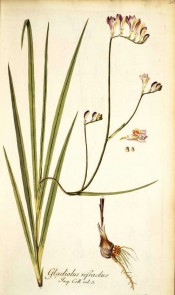Freesia refracta (Jacq.) Klatt
Cormous perennial with a basal fan of leaves and racemes of scented greenish to dull purple flowers with yellow to orange markings on long, branched, arching stems in winter and spring. To 45cm. [RHSE, Hortus, CECB].
Horticultural & Botanical History
‘This present [Tritonia refracta] is one of the rarest species of the tribe; and, as far as we can trace, has been now first introduced from the Cape of Good Hope by Messrs. Lee and Kennedy of the Hammersmith Nursery. […] A hardy greenhouse plant; requiring to be kept in peat-earth, and to have the bulbs taken up, and the offsets removed at least every second year.’ [BR f.135/1816]. Tritonia refracta was introduced to Britain in 1815. [JD]. Jacq. IPR pl.241/1781-93.
History at Camden Park
First recorded in an Addendum to the 1843 catalogue and listed in every subsequent catalogue [B.432/1843]. Bulbs were sent to William Macleay in October of 1843. [MP A2948-3].
Notes
Published Oct 20, 2009 - 03:14 PM | Last updated Jul 23, 2010 - 11:53 AM
| Family | Iridaceae |
|---|---|
| Category | |
| Region of origin | South Africa, Cape district |
| Synonyms |
|
| Common Name | |
| Name in the Camden Park Record | Tritonia refracta |
| Confidence level | high |
